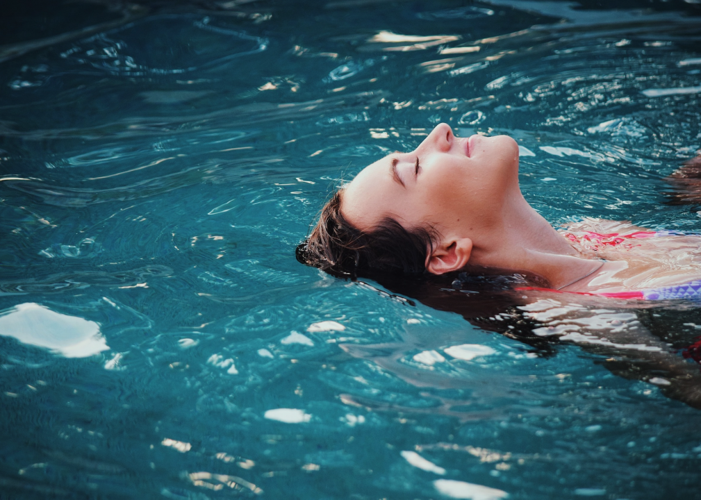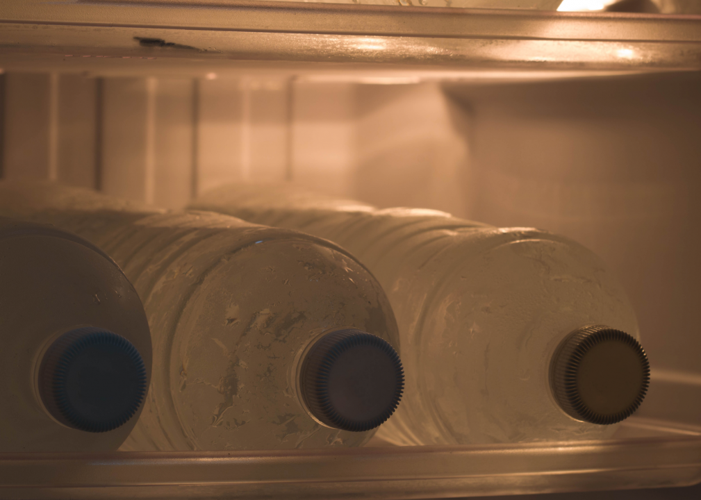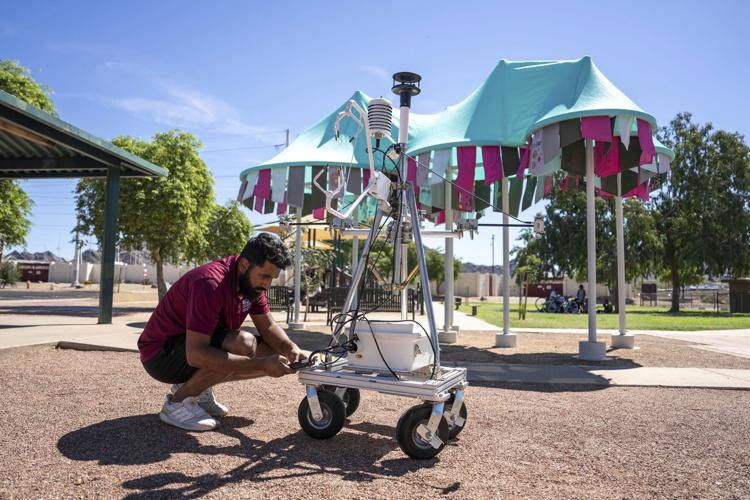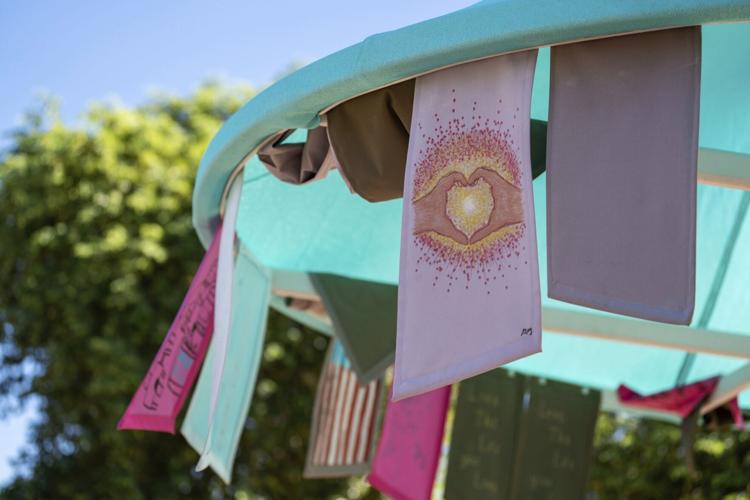LA CANADA FLINTRIDGE, Calif. — When sculptor Bobby Zokaites moved to Phoenix in summer 2011, walking the half-mile to classes at Arizona State University in triple-digit heat felt risky. He learned to find shade along his route — resting in a stoplight's sliver of it, dodging the sizzling sun at each opportunity.

Edward Shephard, left, and Adrian Simpson play basketball near a temporary public art piece that provides shade Aug. 30 at Sunnyslope Park in Phoenix, Ariz.
Samantha Chow, Associated PressPeople are also reading…
- Burke County manufacturing facility lays off 50 employees due to contract cancellation
- Election final update: Election results in Burke County municipal races
- 3 people from Burke County charged after 135 grams of meth found in car
- Skeletal remains found by railroad tracks in Valdese near Praley Street SW on Tuesday
- Burke County Public Schools, administrators sued by victim of former teacher convicted of sex crimes
- 'Step Up For Valdese' candidates sweep town council, mayoral election
- Equipment malfunction blamed for too-deep rumble strips on highway between ¶®É«µŰ and Lenoir
- See the results of elections in Valdese, Glen Alpine, Drexel, ¶®É«µŰ and Connelly Springs
- Burke County man charged with sex crimes against a minor
- Don't want illicit sex parlors in your town? Here's how one city kicked them all out.
- Hickory restaurant opens doors for breakfast, lunch, dinner. "It's like a big chef's table."
- ¶®É«µŰ to add extra police patrol to areas where there is more speeding, crashes
- Hudson 4-year-old dies 2 days after reported assault; Man faces child abuse charge
- North Carolina man — known as 'Big Candy' — celebrates his Halloween birthday with celebration
- Disturbance at Connelly Springs Dollar General leads to arrest of man wanted on federal drug charges

Arizona State University doctoral student Muhammad Abdullah sets up MaRTY, an instrument used to take measurements in direct sun and shade, at the Reflections on Sunnyslope shade structure Aug. 30 at Sunnyslope Park in Phoenix, Ariz.
Samantha Chow, Associated Press
United States - September 17, 2025 Western Atlantic – A new study warns that most coral reefs in the western Atlantic could soon stop growing …

Reflections on Sunnyslope, an art piece by Jessica Arias that also functions as a shade structure, stands at Sunnyslope Park on Aug. 30 in Phoenix.
Samantha Chow, Associated Press
2021 is already shaping up to be a hot year, with spring temperatures and hot streaks across much of the continental U.S into June. In May 2021,Ěý there were 947 record warm recorded across the U.S., according to the National Oceanic and Atmospheric Administration (NOAA).Ěý scoured scientific studies, DIY websites, and even American history to come up with 15 ways to stay cool on warm days without AC.
For anyone not living along the northern edges or mountains of the U.S.,Ěýthe dog days of summer feature weeks—if not months—on end of intolerable heat. SizzlingĚý to negatively affect memory, reaction time, productivity, moods, and even suicide rates. One study by tracked students before and after a heatwave and determined that higher temperatures correlated with decreased cognitive function; another by Stanford University in 2018 studied the links between and ultimately theorized that bumps in temperature from now through the year 2050 may correlate with an added 21,000 deaths from suicide.
- Unsplash

Despite one's best efforts to reapply sunscreen as directed, being out in the sun all day can still lead to sunburn and skin damage. The medicinal use of aloe vera to help treat skin ailments can be tracked all the way The antiseptic aloe vera is ultimately a wonder plant: In skin care applications it acts as a cleanser, astringent, and moisturizer, and it can stimulate the growth of new skin tissue, while also calming the nervous system. For an extra cooling effect, mix water and aloe vera in ice cube trays, and pop them into the freezer for use when needed.
- Alena A // Shutterstock

Whether your skincare routine involves multiple products or just one, keeping them in the refrigerator can make for a refreshing reprieve from the heat. Many lotions, serums, sprays, and masks will even keep their potency for longer when kept cold.
- Red Confidential// Shutterstock

There is no better way to heat upĚýa home in the summer than by switching on the oven, burners, or toaster oven. Avoid that entirely by grilling outside, eating out, or switching things up with meals that don't require the stove on the hottest days. Salads, cold sandwiches, cold soups like gazpacho, and nori rolls are all great options for hot days.
- Unsplash

Strategic placement of fans throughout the home can completely change an indoor climate. Window fans pulling in cooler outside air should be positioned on the first floor of the shadiest, coolest side of the home (most likely in a north-facing window). A fan blowing out the window, which will suck warmer air from inside, should be placed on the sunniest, hottest side of the second floor (or same floor if it's a one-story home or apartment). Ceiling fans should be rotating counter-clockwise (from your vantage point below it)—don't forget to reverse this direction during cooler months!
- mariait // Shutterstock

Besides keeping your body hydrated, drinking water helps regulate internal temperatures. Keep your hydration levels topped off throughout the day and evening to ensure heat is being managed most effectively by your most powerful weapon. The American Heart Association recommends —for a high school football player, that can be up to fiveĚýpounds in one summer practice, or 80 ounces.
You may also like:Ěý
- Yevhen Vitte// Shutterstock

Hot water bottles are built to keep people warm on cold nights, but they can also serve the opposite purpose. Fill your hot water bottle (or a regular water bottle, if that's what you have) with tap water, for a few hours, and then sleep with the bottle at your feet. Your feet are one of the most temperature-sensitive parts of your body, so keeping them cool will help the rest of your body stay cool.
- mr.kriangsak kitisak // Shutterstock

While a west-facing home may be perfect in winter, it makes cooling the house down in the summer a bitĚýmore challenging. Stock up on reusable Ěýto keep the sun's harmful rays out and the cool air in (it will also work to keep your home warm in the winter). Tinfoil and space blankets work great for blocking heat from windows, too, and may save you a few bucks.
- Chumrit Tejasen // Shutterstock

Cotton is a great whether you live in the dry heat of Arizona or humid Florida; this light material allows air to circulate without getting trapped in one place, cooling your body naturally. Other fabrics that can help you fight off the sweat are chambray, rayon, linen, and synthetic blends, and lighter colors are generallyĚýcooler than darker colors.
- Unsplash

Drinking a lot of water is one way to stay hydrated during the summer, but it can also be done through eating . This includes fruits and vegetables such as melons, cucumbers, lemons, grapes, leafy greens, and berries. Spicy foods prepared with chili peppers are great coolers as well: the chilis increase circulation and cause perspiration. And while ice cream might seem refreshing in the moment, it will only make you feel warmer in the long run—flavored ice is a good alternative.
- Unsplash

It seems counterintuitive, but drinking something hot on a warm, dry day can help to cool a body off. A found that drinking a hot beverage increases sweat production, which in turnĚýcools the body off. There's just one caveat—the sweat needs to be able toĚýevaporate in shortĚýorder. This trick will not work if you're wearing a lot of clothing that can trap sweat or if the scorching day is paired with high humidity.
You may also like:Ěý
- Pixabay

Strategically opening windows at night when the air is coolest and keeping them closed (with curtains drawn!) during the day is one of the most straightforward ways to keep a home cooler in summer months. This method is most effective if you have adequate insulation in the walls to trap the cooler night air inside. Another window trick is to take advantage of convection: When double-hung windows are open, keep them as suchĚýat the top and the bottom. Having the top window cracked allows hot air to escape, while the bottom window being cracked will suck in cooler air from outside.
- Unsplash

PlanĚýaheadĚýfor hot nights: fold up a top sheet, put it in a bag, and set said bag in the freezer a few hours before bed. When it's time to hit the hay, take the sheet out and lay it on top of you. For a last-minute (slightly messier) iteration of the same technique, before going to bed wet down a top sheet in cold water, wring the sheet out well, and put it over yourself.
- Unsplash

In addition to keeping windows closed during the day and open at night, use blackout curtains to trap cool air inside and keep the heat from coming in. They've been said to reduce heat transfer through windows by as much as 24%—that's a lot of degrees when it's sweltering outside.
- Unsplash

Pranayama is the practice of breath control—and utilizing it can make you feel noticeably cooler. Two breaths, in particular, that can help are the sitali (“cooling breath”) and sitkari (“sipping” or “hissing”). In the sitali, the mouth is opened into an “O,” and the tongue folded lengthwise into a tube to suck air through. After sticking the curled tongueĚýout almost an inch from the lips,Ěýa big breath is drawnĚýin, using the tongue like a drinking straw. This will pull cool air into the diaphragm. After breathing in, the mouth is closed and air slowly exhaled through the nose. The sitkari variation of this breath involves closing the top and bottom teeth together with lips open in a smile. Long, slow breaths are drawn in this position through the teeth and mouth, then the mouth is closed and the breath exhaled slowly through the nose.
- Microgen // Shutterstock
15 ways to stay cool this summer without AC
![]()
15 ways to stay cool this summer without AC
2021 is already shaping up to be a hot year, with spring temperatures and hot streaks across much of the continental U.S into June. In May 2021,Ěý there were 947 record warm recorded across the U.S., according to the National Oceanic and Atmospheric Administration (NOAA).Ěý scoured scientific studies, DIY websites, and even American history to come up with 15 ways to stay cool on warm days without AC.
For anyone not living along the northern edges or mountains of the U.S.,Ěýthe dog days of summer feature weeks—if not months—on end of intolerable heat. SizzlingĚý to negatively affect memory, reaction time, productivity, moods, and even suicide rates. One study by tracked students before and after a heatwave and determined that higher temperatures correlated with decreased cognitive function; another by Stanford University in 2018 studied the links between and ultimately theorized that bumps in temperature from now through the year 2050 may correlate with an added 21,000 deaths from suicide.
- Unsplash
Despite one's best efforts to reapply sunscreen as directed, being out in the sun all day can still lead to sunburn and skin damage. The medicinal use of aloe vera to help treat skin ailments can be tracked all the way The antiseptic aloe vera is ultimately a wonder plant: In skin care applications it acts as a cleanser, astringent, and moisturizer, and it can stimulate the growth of new skin tissue, while also calming the nervous system. For an extra cooling effect, mix water and aloe vera in ice cube trays, and pop them into the freezer for use when needed.
- Alena A // Shutterstock
There is no better way to heat upĚýa home in the summer than by switching on the oven, burners, or toaster oven. Avoid that entirely by grilling outside, eating out, or switching things up with meals that don't require the stove on the hottest days. Salads, cold sandwiches, cold soups like gazpacho, and nori rolls are all great options for hot days.
- Unsplash
Strategic placement of fans throughout the home can completely change an indoor climate. Window fans pulling in cooler outside air should be positioned on the first floor of the shadiest, coolest side of the home (most likely in a north-facing window). A fan blowing out the window, which will suck warmer air from inside, should be placed on the sunniest, hottest side of the second floor (or same floor if it's a one-story home or apartment). Ceiling fans should be rotating counter-clockwise (from your vantage point below it)—don't forget to reverse this direction during cooler months!
- mariait // Shutterstock
Besides keeping your body hydrated, drinking water helps regulate internal temperatures. Keep your hydration levels topped off throughout the day and evening to ensure heat is being managed most effectively by your most powerful weapon. The American Heart Association recommends —for a high school football player, that can be up to fiveĚýpounds in one summer practice, or 80 ounces.
You may also like:Ěý
- Yevhen Vitte// Shutterstock
Hot water bottles are built to keep people warm on cold nights, but they can also serve the opposite purpose. Fill your hot water bottle (or a regular water bottle, if that's what you have) with tap water, for a few hours, and then sleep with the bottle at your feet. Your feet are one of the most temperature-sensitive parts of your body, so keeping them cool will help the rest of your body stay cool.
- mr.kriangsak kitisak // Shutterstock
While a west-facing home may be perfect in winter, it makes cooling the house down in the summer a bitĚýmore challenging. Stock up on reusable Ěýto keep the sun's harmful rays out and the cool air in (it will also work to keep your home warm in the winter). Tinfoil and space blankets work great for blocking heat from windows, too, and may save you a few bucks.
- Chumrit Tejasen // Shutterstock
Cotton is a great whether you live in the dry heat of Arizona or humid Florida; this light material allows air to circulate without getting trapped in one place, cooling your body naturally. Other fabrics that can help you fight off the sweat are chambray, rayon, linen, and synthetic blends, and lighter colors are generallyĚýcooler than darker colors.
- Unsplash
Drinking a lot of water is one way to stay hydrated during the summer, but it can also be done through eating . This includes fruits and vegetables such as melons, cucumbers, lemons, grapes, leafy greens, and berries. Spicy foods prepared with chili peppers are great coolers as well: the chilis increase circulation and cause perspiration. And while ice cream might seem refreshing in the moment, it will only make you feel warmer in the long run—flavored ice is a good alternative.
- Unsplash
It seems counterintuitive, but drinking something hot on a warm, dry day can help to cool a body off. A found that drinking a hot beverage increases sweat production, which in turnĚýcools the body off. There's just one caveat—the sweat needs to be able toĚýevaporate in shortĚýorder. This trick will not work if you're wearing a lot of clothing that can trap sweat or if the scorching day is paired with high humidity.
You may also like:Ěý
- Pixabay
Strategically opening windows at night when the air is coolest and keeping them closed (with curtains drawn!) during the day is one of the most straightforward ways to keep a home cooler in summer months. This method is most effective if you have adequate insulation in the walls to trap the cooler night air inside. Another window trick is to take advantage of convection: When double-hung windows are open, keep them as suchĚýat the top and the bottom. Having the top window cracked allows hot air to escape, while the bottom window being cracked will suck in cooler air from outside.
- Unsplash
PlanĚýaheadĚýfor hot nights: fold up a top sheet, put it in a bag, and set said bag in the freezer a few hours before bed. When it's time to hit the hay, take the sheet out and lay it on top of you. For a last-minute (slightly messier) iteration of the same technique, before going to bed wet down a top sheet in cold water, wring the sheet out well, and put it over yourself.
- Unsplash
Pranayama is the practice of breath control—and utilizing it can make you feel noticeably cooler. Two breaths, in particular, that can help are the sitali (“cooling breath”) and sitkari (“sipping” or “hissing”). In the sitali, the mouth is opened into an “O,” and the tongue folded lengthwise into a tube to suck air through. After sticking the curled tongueĚýout almost an inch from the lips,Ěýa big breath is drawnĚýin, using the tongue like a drinking straw. This will pull cool air into the diaphragm. After breathing in, the mouth is closed and air slowly exhaled through the nose. The sitkari variation of this breath involves closing the top and bottom teeth together with lips open in a smile. Long, slow breaths are drawn in this position through the teeth and mouth, then the mouth is closed and the breath exhaled slowly through the nose.
- Microgen // Shutterstock















